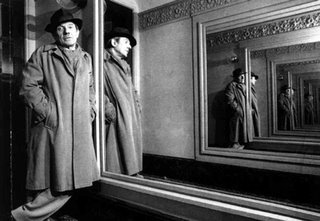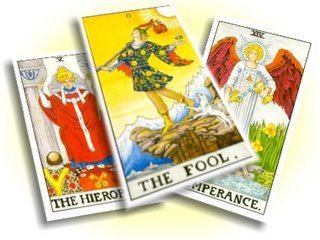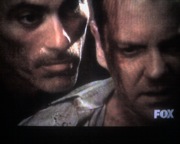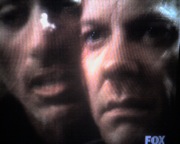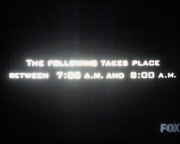I can see (myself) for miles and miles and....
Cross-posted to my social software blog...
I don't normally write personal posts. But last night, during one of those proverbial late-night-staring-at-the-ceiling attempts to sweep the cobwebs from the corners of my mind in order to prepare it for rest, I had what felt like a small-to-middling realization. I remembered realizing, out on the playa one night at Burning Man, that I'd lived all my life unable to tell the difference between anger and resentment. Coming from others, I mean. That when a person was angry with my I immediately thought they resented me. What mattered of course was how this affect my response.
I realized last night, thinking about this project to define the "user" of social software as a user in conversation with him/herself as much as with "real" others, realized that there are some emotions that are easily mistaken online. Really big, important emotions. Though they're not really emotions; they're aspects of communication that involve emotion. But it's precisely because they're not expressed, they're read, that they are easily confused. Empathy and projection. A person might be empathetic or sympathetic, compassionate, in an email, or post, or comment. That would be our reading, our impression. But the person being compassionate might be projecting. Transactional Analysts described these kinds of phenomena as "crossed transactions."
For example: Bossman: Mary, get me a hundred copies of this report by lunch please. Mary: You don't own me you know! I do have other things to do! (They were a bit less PC back then; but you probably recognize the dynamic. Think of Chloe in 24). TA would have called this an adult-child transaction, wherein Mary responds as a child to a demanding parent.
So the thing that hit me was that there are certain kinds of communications, affective or emotionally rich ones, that are handled in face to face talk by use of body language, face, and of course the fact within seconds we can establish, by walking up or down the ladder of intensity and risk, each other's intentions. But in blogging, commenting, emailing, (less so in IM -- because it cycles through short turns and is actually connected to another person), we are required to read/interpret the intention behind what others say. And so we can read them generously, that is assigning to their words what seem to be their intentions. Or we can read them internally, that is through our own emotional complexes, including of course all the things we tend to hear because we're sensitive to them.
Some of the most important aspects of communication, those having to do with interest, with liking a person, with being acknowledged, ignored, agreed with or disagreed with, are essentially up for grabs. If we have emotional cobwebs and detritus, and I don't know a soul who doesn't, we recognize/encounter our own crap in other's words, and assign it to them (unless we're enlightened, in which case we can catch ourselves before answering!). Same with ideals, fantasies, wishes, etc: we might believe they mean it (when in fact *they're* engaged perhaps with their own idealizations). This would explain the tendency in dating sites for people to ascend the ramp to intimacy at great speed, only to then fall from the peak disastrously and walk away in great disappointment. The medium engages us with our own means of understanding another's intentions, but brackets their ability to correct where our heading.
I don't normally write personal posts. But last night, during one of those proverbial late-night-staring-at-the-ceiling attempts to sweep the cobwebs from the corners of my mind in order to prepare it for rest, I had what felt like a small-to-middling realization. I remembered realizing, out on the playa one night at Burning Man, that I'd lived all my life unable to tell the difference between anger and resentment. Coming from others, I mean. That when a person was angry with my I immediately thought they resented me. What mattered of course was how this affect my response.
I realized last night, thinking about this project to define the "user" of social software as a user in conversation with him/herself as much as with "real" others, realized that there are some emotions that are easily mistaken online. Really big, important emotions. Though they're not really emotions; they're aspects of communication that involve emotion. But it's precisely because they're not expressed, they're read, that they are easily confused. Empathy and projection. A person might be empathetic or sympathetic, compassionate, in an email, or post, or comment. That would be our reading, our impression. But the person being compassionate might be projecting. Transactional Analysts described these kinds of phenomena as "crossed transactions."
For example: Bossman: Mary, get me a hundred copies of this report by lunch please. Mary: You don't own me you know! I do have other things to do! (They were a bit less PC back then; but you probably recognize the dynamic. Think of Chloe in 24). TA would have called this an adult-child transaction, wherein Mary responds as a child to a demanding parent.
So the thing that hit me was that there are certain kinds of communications, affective or emotionally rich ones, that are handled in face to face talk by use of body language, face, and of course the fact within seconds we can establish, by walking up or down the ladder of intensity and risk, each other's intentions. But in blogging, commenting, emailing, (less so in IM -- because it cycles through short turns and is actually connected to another person), we are required to read/interpret the intention behind what others say. And so we can read them generously, that is assigning to their words what seem to be their intentions. Or we can read them internally, that is through our own emotional complexes, including of course all the things we tend to hear because we're sensitive to them.
Some of the most important aspects of communication, those having to do with interest, with liking a person, with being acknowledged, ignored, agreed with or disagreed with, are essentially up for grabs. If we have emotional cobwebs and detritus, and I don't know a soul who doesn't, we recognize/encounter our own crap in other's words, and assign it to them (unless we're enlightened, in which case we can catch ourselves before answering!). Same with ideals, fantasies, wishes, etc: we might believe they mean it (when in fact *they're* engaged perhaps with their own idealizations). This would explain the tendency in dating sites for people to ascend the ramp to intimacy at great speed, only to then fall from the peak disastrously and walk away in great disappointment. The medium engages us with our own means of understanding another's intentions, but brackets their ability to correct where our heading.
